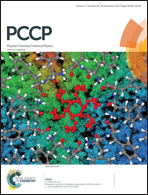The development of a bilayer structure of poly(propylene carbonate)/poly(3-hydroxybutyrate) blends from the demixed melt
Abstract
The miscibility of poly(propylene carbonate) (PPC) and poly(3-hydroxybutyrate) (PHB) blends was analyzed by differential scanning calorimetry (DSC) and polarized optical microscopy (POM). The results indicated that the blends are immiscible at most blending compositions, and a miscible blend can be obtained when the PHB content is as low as 10 wt%. The morphology of the PPC/PHB (70/30) blend film was characterized by POM, scanning electron micrography (SEM) and Fourier transform infrared spectroscopy (FTIR), and the development of a PPC-top and microporous PHB-bottom bilayer structure can be revealed. Different from the normal case, phase separation can take place on the normal direction of the film surface in the PPC/PHB (70/30) blend at 190 °C, attributed to the different surface energies of the two components. The continuous segregation of PPC to the top-layer can result in the crystallization of PHB at the bottom layer and conversely promote the complete development of a bilayer structure. Since the isotropic PPC layer is transparent with no birefringence, the PHB spherulite with a microporous structure at the bottom layer can be observed directly by POM. Moreover, the microporous structure of the bottom layer should be attributed to the solution cast procedure. Thus, some unique crystalline patterns may be created in the demixed crystalline/amorphous polymer blends, which differ greatly from those obtained from the miscible blend systems.


 Please wait while we load your content...
Please wait while we load your content...